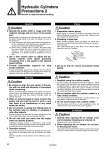
m-03-3c-seihin_en 67 / 77
10秒後にBOOKのページに移動します
Wrapping direction Sealant tape Expose approx. 2 threads Hydraulic Cylinders Precautions 2 Be sure to read this before handling. Selection 1. Operate after opening the air release valve and completely releasing any internal air. Residual air can cause malfunction. 2. When adjusting the air release, do not loosen the plug too much. Use caution, since loosening the plug too much may cause it to fly out or fluid to blow out, posing a danger of human injury. Air Release Caution Caution 1. Readjust using the cushion needle. Cushion needles are adjusted at the time of shipment. When the cylinder is put into service, the cushion needles should be readjusted based on factors such as the size of the load and the operating speed. When the cushion needles are turned clockwise, restriction of the air flow becomes greater and thus the cushioning effect also increases. 2. Do not operate with the cushion needle in a fully closed condition. This will contribute to the generation of surge pressure, and the cylinder or equipment can be damaged. 3. Do not overly loosen the cushion needle. This may cause oil to flow out. (As a guideline, loosen the needle 2 turns or less from the fully closed position). Cushion Caution 1. Be certain to align the axis center of the piston with the load and direction of movement when connecting. When not properly aligned, twisting of the piston rod and tubing may occur, and damage may be caused due to wear on areas such as the inner tube surface, bushings, piston rod surface and seals. 2. When an external guide is used, connect the piston rod end and the load in such a way that there is no interference at any point within the stroke. 3. Do not scratch or gouge the sliding parts of the cylinder tube by striking or grasping it with other objects. Cylinder bores are manufactured to precise tolerances so that even a slight deformation may cause faulty operation. 4. Do not use until you verify that the equipment can operate properly. Following mounting, repairs, or conversions, verify correct mounting by conducting suitable function and leakage tests after piping and power connections have been made. 5. Operation manual The product should be mounted and operated after the operation manual is thoroughly read and its contents are understood. Keep the operation manual where it can be referred to as necessary. 2. Operate the piston within a range such that collision damage will not occur at the stroke end. Operate within a range such that damage will not occur when the piston having inertial force stops by striking the cover at the stroke end. (1) Take load factors and piston speed (Best Pneumatics No. 8) into consideration and determine the operability by referring to the chart under “Selection Standards”. (2) When using a cylinder with no cushion, the speed when the piston strikes the cover should be reduced to 50 mm/sec or lower (a level at which no metallic sound is generated), or a stopper should be installed on the outside. 3. Use a flow control valve to adjust the hydraulic cylinder drive speed, gradually increasing from a low speed to the desired speed setting. 4. Provide intermediate supports for long stroke cylinders. Provide intermediate supports for cylinders with long strokes to prevent piston rod damage due to sagging of the piston rod, deflection of the tube, vibration, and external loads. Mounting Caution 1. Preparation before piping Before piping is connected, it should be thoroughly blown out with air (flushing) or washed to remove chips, cutting oil and other debris from inside the pipe. 2. Wrapping of pipe tape When screwing together pipes and fittings, be certain that chips from the pipe threads and sealing material do not get inside the piping. Also, when sealant tape is used, leave 1.5 to 2 thread ridges exposed at the end of the pipe. 3. Set up so that air cannot accumulate inside piping. Piping Caution 62